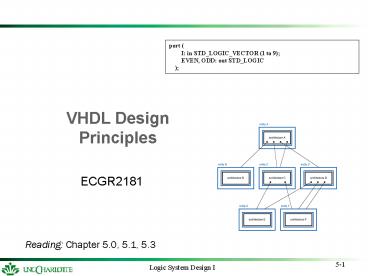VHDL Design Principles - PowerPoint PPT Presentation
Title:
VHDL Design Principles
Description:
port (I: in STD_LOGIC_VECTOR (1 to 9); EVEN, ODD: out STD_LOGIC); VHDL Design Principles ECGR2181 Reading: Chapter 5.0, 5.1, 5.3 – PowerPoint PPT presentation
Number of Views:134
Avg rating:3.0/5.0
Title: VHDL Design Principles
1
VHDL DesignPrinciples
port ( I in STD_LOGIC_VECTOR (1 to 9)
EVEN, ODD out STD_LOGIC )
- ECGR2181
Reading Chapter 5.0, 5.1, 5.3
2
HDL-based design flow
- For ASICs, verification and fitting phases are
usually much longer (as a fraction of overall
project time) than what youve experienced in
class.
3
VHDL
- Developed in the mid-1980s under DoD sponsorship
- Mandated for federally-sponsored VLSI designs
- Used for design description, simulation, and
synthesis - Synthesis became practical in the early 90s and
use of VHDL (and Verilog) has taken off since
then - Only a subset of the language can be synthesized
4
VHDL entity and architecture concept
- System is a collection of modules.
- Architecture detailed description of the
internal structure or behavior of a module. - Entity a wrapper for the architecture that
exposes only its external interfaces, hiding the
internal details.
5
VHDL Hierarchy
6
VHDL program file structure
- Entity and architecture definitions for different
modules can be in different files. - Compiler maintains work library and keeps track
of definitions using entity and architecture
names.
7
VHDL -- designed by committee
- Tries to be all things to all people.
- Result -- very general, but also very complex.
- Standard logic values and elements are not
built-in. - Standard logic defined by a package, IEEE 1164
STD_LOGIC. - Must be explicitly used by program.
8
Standard logic values -- not just 0,1
- Need additional values for simulation,
three-state logic, pull-ups, etc. - Defined in IEEE 1164 STD_LOGIC package.
9
Logic functions defined by table lookup
10
VHDL strong typing
- Every signal, variable, function parameter, and
function result has a type. - A few built-in types, plus user defined types.
- In assignment statements, comparisons, and
function calls, types must match. - Commonly used IEEE-1164 types
- STD_LOGIC (one bit)
- STD_LOGIC_VECTOR(range) (multibit vector)
- INTEGER (built-in integer type)
- Pain in the neck Must explicitly convert between
INTEGER and STD_LOGIC_VECTOR.
11
- library IEEE
- use IEEE.std_logic_1164.all
- entity parity9 is
- port (
- I in STD_LOGIC_VECTOR (1 to 9)
- EVEN, ODD out STD_LOGIC
- )
- end parity9
architecture parity9p of parity9 is begin process
(I) variable p STD_LOGIC variable j
INTEGER begin p I(1) for j in 2 to
9 loop if I(j) '1' then p not p end
if end loop ODD lt p EVEN lt not
p end process end parity9p
12
VHDL programming styles
- Structural
- Define explicit components and the connections
between them. - Textual equivalent of drawing a schematic
- Dataflow
- Assign expressions to signals
- Includes when and select (case) statements
- Behavioral
- Write an algorithm that describes the circuits
output - May not be synthesizable or may lead to a very
large circuit - Primarily used for simulation
13
Example 2-to-4 decoder
EN I1 I0
Y3 Y2 Y1 Y0
14
Example 2-to-4 decoder
15
Example 2-to-4 decoder
Architecture
16
Dataflow-style program for 3-to-8 decoder
17
(No Transcript)
18
(No Transcript)
19
Dataflow-style program for 3-to-8 decoder
Note All assignment statements operate
concurrently (combinational circuit ).
20
Behavioral program style
- Normally uses VHDL processes
- Each VHDL process executes in parallel with other
VHDL processes and concurrent statements - Concurrent statements include assignment and
select statements in dataflow-style programs - Concurrency is needed to model the behavior of
parallel, interconnected hardware elements - But sequential statements can be used within a
process
21
VHDL process
- A sequence of sequential statements.
- Activated when any signal in the sensitivity
list changes. - Primarily a simulation concept, but can be
synthesized
22
Behavioral version of 74x138
Except for different syntax, approach is not all
that different from the dataflow version
23
Truly behavioral version
May not be synthesizable, or may have a slow or
inefficient realization. But just fine for
simulation and verification.
24
- library IEEE
- use IEEE.STD_LOGIC_1164.ALL
- --Declaration of the module's inputs and outputs
- entity fewgates is port (
- A in std_logic
- B in std_logic
- C in std_logic
- Y out std_logic )
- end fewgates
- --Defining the modules behavior
- Architecture behavioral of fewgates is
- begin
- process (A, B, C) begin
- Y lt C OR ((NOT A) AND (NOT B))
- end process
- end behavioral
25
More VHDL
- Powerful facilities for generating iterative
circuit descriptions (e.g., multiplier array) - Facilities for modeling timing behavior of known
components - Program I/O facilities for use in simulation
- Design-management facilities for selecting
alternative components and architectures - And more...































